31 Days, 31 Lists: 2023 Easy Books and Early Chapter books

I can’t decide, so I’ll put it to you. Is the most difficult kind of book to write for children a picture book, a poetry book for kids, an easy book, or an early chapter book? I’m going to rule out picture book, since we see a fair number of really excellent titles on a regular basis. And I’m taking out poetry, because while writing a good book of it is hard, yes indeed, there’s something about not having a plot that kind of frees you. Now we’re down to easy books and early chapter books, two types of titles with particularly tricky elements apiece. A truly great easy book must use literally the simplest of words to convey a title so interesting that it makes a child want to know how to read. But an early chapter book has the additional obligation of transitioning children from those easy books into long chapter books. If it fails, it sets the kid back. As a result, I’m going to declare them a tie. BOTH easy books and early chapter books are the hardest types of titles to write for kids. That’s why it gives me so much pleasure to present you today with this incredible list of really and truly magnificent examples of the form. Read them. Learn from them. Then let your kids learn from them as well.
For the full PDF of this list, you can find it here.
Interested in previous years? Then check out the following. Just note that in the past I’d turn Easy Books into their own list and Early Chapter Books into their own list. Something I may consider doing again someday . . .
ADVERTISEMENT
ADVERTISEMENT
2023 Easy Books
Bear and Bird: The Picnic and Other Stories by Jarvis
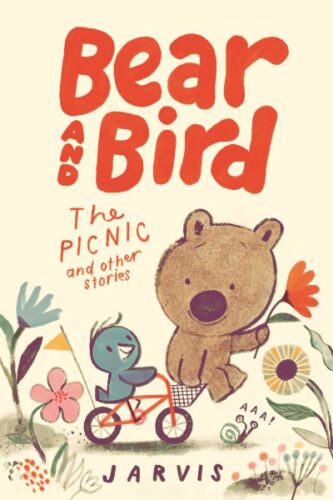
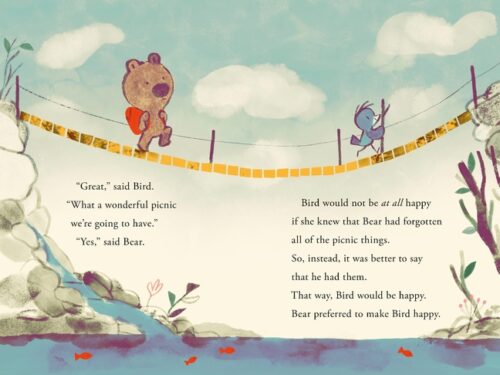

Four short stories about two good friends. Bird and Bear are best friends. Completely charming illustrations accompany these tales of misunderstandings, kindness, and laugh-out-loud situations. I think this might be one of my favorite books of the year. This is just a clear cut case of what happens when someone really knows how to write simple words for beginning readers. The tone, man, the tone! Jarvis has been illustrating books for years. I had no idea he was this good at writing them too!! Each story in this book is strong and there are whole sentences that slayed me. “Everything was resting on this leaf. This randomly plucked leaf. This slightly soggy leaf.” There is just such kindness emanating from these tales. I’m completely charmed by it. I will fight hard for it (but I don’t think I’ll have to as it sells itself).
Fox Has a Problem by Corey R. Tabor
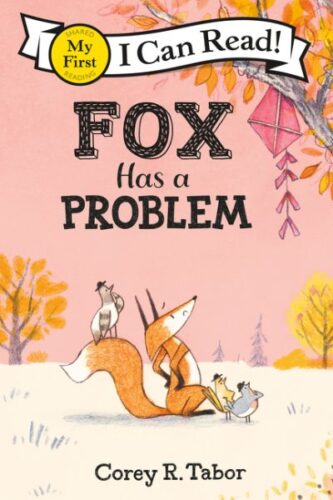
Doggone it, Corey. Stop being quite so good at what you do! You know, it seems just a little unfair to me that Mr. Tabor has managed to not only conquer the Easy Book genre with his inimitable Fox series, but picture books as well. You graphic novelists out there better start watching your backs. This man has talents. In this particular case we’re looking at a pretty darn simple easy book where our hero, the titular Fox, has gotten his kite caught in a tree. But the whole reason this book works as brilliantly as it does is that Tabor is a master of not simply the page turn but the funny page turn. So the first page may show Fox looking at his inaccessible kite as it says, “Fox has a problem.” Then you turn the page and see a small forest filled with kites caught in trees as the book says with incredible simplicity, “It is not a new problem”. Charlie Brown has NOTHING on Fox. The cure soon proves worse than the disease, and here I am with my jaw on the floor, in perfect awe of Tabor’s skills. Not since the Elephant and Piggie books have we had someone write easy books with this much raw talent. I say if you read only one easy book this year, read this one. Previously Seen On: The Funny list.
Gigi and Ojiji: Food for Thought by Melissa Iwai
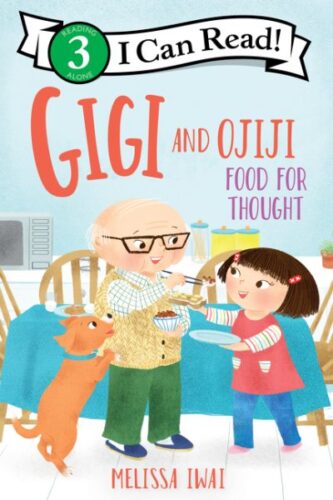
On the one hand you can hear me nattering on about how I don’t like to put sequels on my lists as a general rule. Then you see me do two of them in a row on today’s list and… dagnabbit. But what was I supposed to do? Melissa Iwai already had knocked it out of the park last year when she created Gigi and Ojiji, so what was I supposed to do when I saw that there was another book in the series? I guess when I read it I could have convinced myself that it didn’t stand up to the original, but as it turns out Ms. Iwai is particularly good at tapping into the emotions of your average 1st or 2nd grader. This book talks about the classic family thing that happens when an older family member has to pretend to like the food a kid serves them, and then fails to cover their tracks. When Gigi makes peanut butter toast with bananas for her Ojiji, she is crestfallen when she finds that he didn’t take more than a bite. With her mom’s guidance they decide to make a Japanese breakfast for him the next day with pickles, salmon, miso soup, natto, and rice. This book contains a sentence that is perfect in its brevity about the natto: “It tasted like it smelled.” As a recovering picky eater, I consider any book about trying new foods, ESPECIALLY at breakfast, a story of bravery. Honesty too, I suppose.
Hornbeam All In by Cynthia Rylant, ill. Arthur Howard
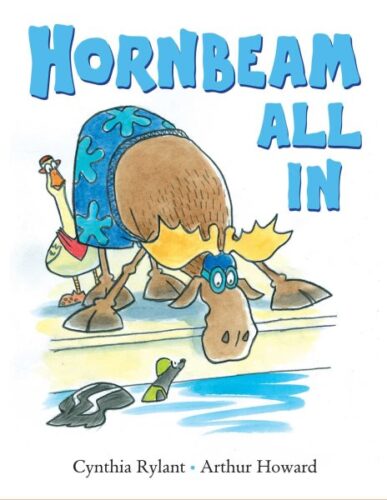
Years ago (and I may have told this story before) I was working in the Central Children’s Room of New York Public Library when a nice man introduced himself at the desk. He was none other than Arthur Howard, and when I learned of this fact I immediately ran over to the Reference section (we had an extensive one in those days) and pulled as many books he’d illustrated as possible for him to sign. He was so modest that he seemed to have some difficulty believing that this was something I would want, but I most certainly did. No one draws like Arthur Howard. My personal favorite of all his books was the Bubba and Bo series with Kathi Appelt. Of course, he’s been working with Cynthia Rylant for decades now but that doesn’t mean they’ve lost any of their panache together. They now appear to have started a new easy book series starring an easygoing moose and his friends. Rylant uses terms like “an ocean of geese” (to describe a goose-related family reunion) and “Hornbeam was all in” (when he chooses to swim). Howard, meanwhile, is having a lot of fun conjuring up various goose relatives and inventing terrible swim trunks for moose. Like the aforementioned Bird and Bear books by Jarvis, this book is often about good folks making a little space for other folks, even if it costs them something (sleep, potato salad, etc.). It’s a small-discomforts-for-the-greater-good book. Something, I think, the world may need a bit more of.
How to Love a Pony by Michelle Meadows, ill. Sawyer Cloud

I was never a pony girl myself. As a kid I remember very much enjoying an Apple paperback that I’d acquired at a Scholastic Book Fair about a girl and a bunch of magical horses (50 points to anyone who can name that book), but that was a far as I went. Even so, I realize that there are scads of kids out there that are pony crazy, and I can’t blame them for it. A giant pet that you can ride? Sells itself. This book centers Lily and her (according to the publisher) Welsh pony. It rhymes, and does so with aplomb. I never had a moment to shudder at the scansion. Best of all, it manages in a relatively few number of words to show that a lot of work goes into taking care of a pony. Everything from brushing it to determining if it’s been injured, and what to do if it is. Cloud, for her part, never anthropomorphizes the pony’s facial features, for which I was INFINITELY grateful. The whole book somehow manages to take place over the course of a year, and it’s lovely. I can recognize when someone takes a concept and makes it work as well as this book does on the page.
Kitty-Cam by Margie Palatini, ill. Dan Yaccarino
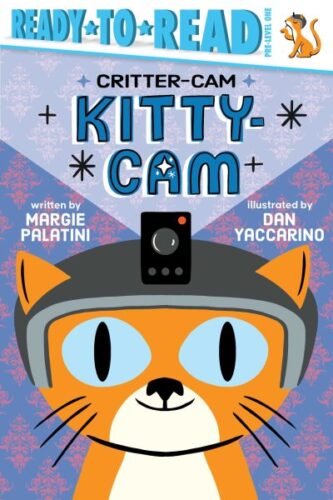
Camera firmly attached to its head, follow a curious kitty as it goes about its day, getting into all kinds of mischief. A fabulous story for the very earliest of new readers. Always bearing in mind just how difficult it is to write a cohesive story at SUCH a young level (this is listed as “Pre-Level One”, which I suppose means it is the most basic of beginner books) I was really very impressed by Palatini’s storytelling skills. I mean, I already instinctively love Dan Yaccarino’s art, so no worries there. But the idea of switching to a cat-eye-view as it attempts to get into various kinds of trouble? Brilliant. This is an extremely difficult kind of book to write with words just this simple. I just think Palatini and Yaccarino really knocked this out of the park.
Makeda Makes a Birthday Treat by Olugbemisola Rhuday-Perkovich, ill. Lydia Mba
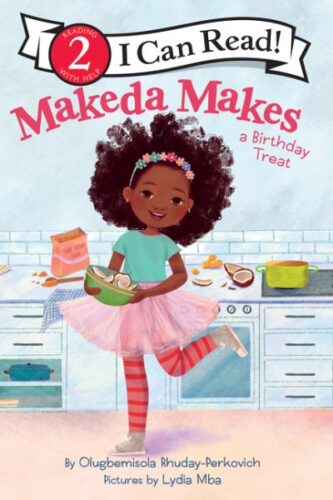
You know, you have to admire a book that acknowledges that sometimes kids are jerks to one another. And I’m all for easy books that put a drop of complexity into the mix. The central conflict of this book centers on the fact that for her birthday Makeda has decided to eschew the standard birthday cupcakes that all her other classmates do. She would much rather make coconut drops and refuses to listen to the warning that they may not go down well with the other kids. And sure as shooting, the minute they realize that these aren’t cupcakes, the kids turn on Makeda’s dessert. Now it all end up fine and dandy by the end (her friend Glory proclaims them to be delicious, so the other kids try them) but there’s some real worry of ostracizing for a moment there, and I liked that. Too often an easy book will select the path of least resistance and eschew the more interesting storytelling route. This one isn’t afraid of a bit of hurt feelings. Looking forward to more of these books in the future.
Mossy and Tweed: Double Trouble by Mirka Hokkanen
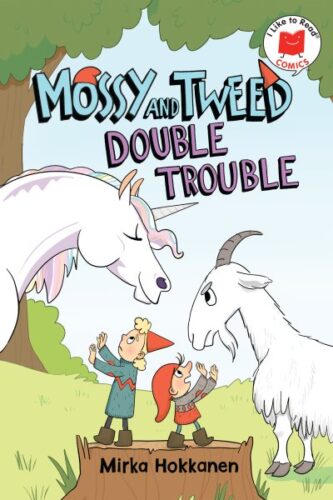
I like enormous world building when it’s done in tiny packages. So this book is part of the Holiday House “I Like to Read Comics” series, and as such some of the text is definitely on the more advanced side of things. I wouldn’t necessarily hand this to a beginning reader, then, but for someone who’s a little more comfortable with their reading, this makes for a nice transitional reader into slightly older comics. The story, as it stands, involves a bunch of gnomes who’ve set up a nice little life in the Gnome Woods and who have a resident “unicorn” who is, as any reader will be able to tell, a one-horned goat. So when a REAL unicorn comes to town, tensions are at an all time high. This book has a lot of the energy of Bob Shea’s classic picture book Unicorn Thinks He’s Pretty Great (which remains one of my favorite picture books of all time, by the way). The difference, aside from tone, is the fact that Hokkanen packs in a HUGE amount of story with few words and few pages. I was quite besotted of this little early reader. Consider it for kids who love unicorns, as well as kids who hate ‘em (or are merely unicorn agnostic).
Nat the Cat Takes a Bath by Jarrett Lerner
Nat the Cat Takes a Nap by Jarrett Lerner
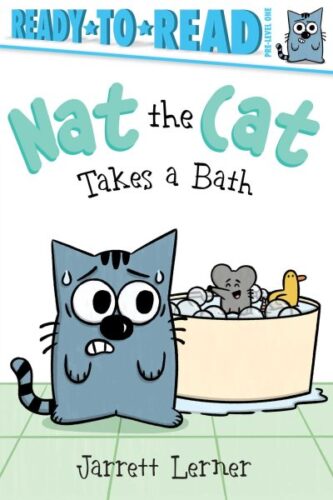
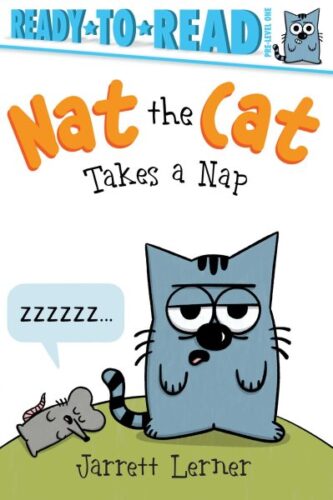
Oo! A new easy book character to read relentlessly for years! And read I shall! Here we have Nat, a semi-rectangular feline with triangle ears. In Takes a Bath, with the requisite number of flies buzzing about his ears, Nat is slated to take a bath… and he don’t wanna. So how do you get a whole book out of that? As it turns out, the delay tactics of children with limited vocabularies transfer perfectly over to cats who feel the same way. Meanwhile, in Takes a Nap, Nat is trying to sleep but the book’s narrator is keeping him from his forty winks with funny results. I thought the text in both books nicely appropriate for kids first wrapping their heads around slightly longer words like “because” and “bubbles” and “scared”. Now with Nat and the Rat named Pat’s dialogue balloons, coupled with the simpler narration, it would be possible to have a child reading aloud the narrator’s part, alongside a better reader doing Nat’s. Particularly since Nat gets all the good emotional moments (I was particularly fond of him going “And… and… and…”)
Problem Solved by Jan Thomas

I would walk across red hot coals to get my hands on the next Jan Thomas book, you betcha. She’s one of those author/illustrators that somehow had a pitch perfect instinct from day one for writing picture books with simple texts. But what always appeals to me in addition to her writing is her ability to tap into the occasional bout of crazed chaos. You can see it in the whites of the eyes of the problem-solving porcupine on the cover of this book. That’s Pete. When a rabbit with a messy room makes the mistake of saying, “This is a problem”, Pete’s on the scene to help. Sorry, I wrote that wrong. Pete’s on the scene to “help”. Because, you see, Pete’s help comes in the form of doing terribly ridiculous things. He’ll neatly fold the rabbit’s shirts… then attempt to feed them to his goldfish. “PROBLEM SOLVED!” Or he’ll stack up all the blocks… and then attempt to flush them down the toilet. The toilet actually gets a repeat performance in this book (to great comic effect) until Rabbit comes up with a clean room (through constant work following Pete) and a way for Pete to “help” someone else. Thoroughly wacky, but also perfect for new readers. Thomas knocks it out of the park again. Previously Seen On: The Funny List
Snail & Worm, Of Course by Tina Kügler
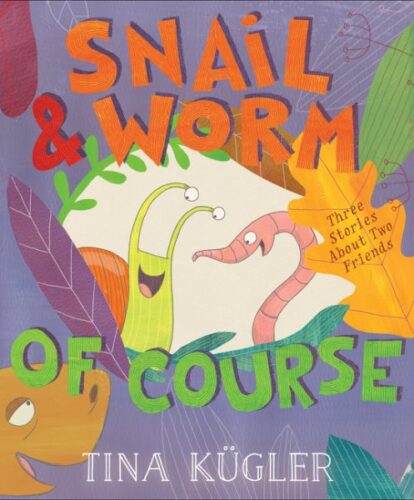
I’m just a sucker for a this, my favorite easy book invertebrate series. Kügler has this way of breaking down the fourth wall ever-so-slightly that I just adore. I will confess that if you’ve seen one Snail & Worm then this is more of the same but WHAT a wonderful sameness it is! The three stories in this particular collection (which I’d say is on about a Frog & Toad-like level) are “The Cloud Flower” where Snail must deal with the impermanence of nature, “The Big Present”, where Snail attempts to give Worm the gift of an entire tree, and finally “Too Small” where Snail has a sudden existential crisis based entirely on size. A high-quality easy book series that keeps putting out great content is worth its weight in gold, if you can find it. Find this one.
Who Will Win? by Arihhonni David

When Bear and Turtle are set to race, will brains win over brawn? A delightful retelling of a traditional Haudenosaunee tale, told in easy to read language for beginning readers. Oh, this works quite well! A traditional Haudenosaunee tale is adapted into Holiday House’s “I Like to Read” series, so honestly this would fit in just as well in the Easy Books category as this Folktale one. I’d heard the tale before but I still found myself surprised by the twist. The art is cartoonish but I really enjoyed it and thought that it served the story well. Previously Seen On: The Fairy Tale, Folk Tale, Religious Tales list
Worm and Caterpillar Are Friends by Kaz Windness
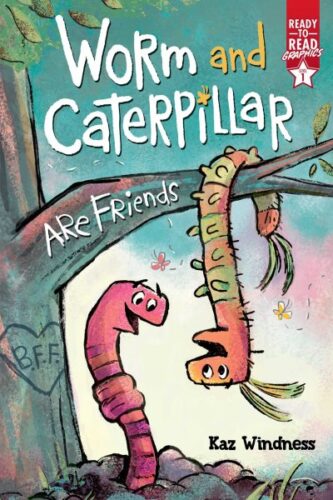


Worm thinks best friends should be exactly alike. Caterpillar knows that differences can also be good. So what happens when Caterpillar goes through a HUGE change? A touching and hilarious tale with lovely art. Y’know, sometimes you gotta read through a lot of easy reading schlock before you find something this good. This is a charming start to what I hope is a series to come. The obliviousness of Worm and the pained knowledge of Caterpillar really come through in this title. The colors are downright sumptuous and I love the deadpan humor throughout. I just keep coming back to the art, though. I’ve never seen Windness’s art before this year and it’s just fantastic! Hope to see more from her in the future. In the meantime, she has a popular Tiktok series that you can follow.
The World and Everything In It by Kevin Henkes

Some future researcher is just going to have a ball with the oeuvre of Kevin Henkes. Particularly if you look at how his work has changed over the decades. If we were to give each of his eras a different name, I’d suggest calling his currently era the Era of Simplicity. This is when he’s paring everything down to its most essential form. Simple words. Clear cut art with clear cut strokes of the brush. Beautiful, most certainly. And the Kevin Henkes lovers out there (which are multitude) love everything that he does. I wouldn’t label him as a risky creator, but there’s something so comforting in his reliability. With that in mind, I’m placing his latest in this Easy Book category. No reason not to. The words here are simple and clear. He indulges in sentences like, “The big things are big,” and “Everything is in the world” which he repeats twice at the end like a mantra. We read a lot of books about how to engage in mindfulness with kids. Skip those. Just give them this book. It’s practically mindfulness incarnate on the page.
2023 Early Chapter Books
The Book That No One Wanted to Read by Richard Ayoade, ill. Tor Freeman

Fun Fact: I had a devil of a time getting any of my librarians to read this book. I suspect that its title, charming though it may be, was a bit to blame. That’s why you have to sell it on its merits rather than its premise. Those merits? Humor for one. The pairing of Freeman to Ayoade was a smart move on someone’s part. Though the writing is droll, Freeman has a real ability to heighten the gags. One in particular that I very much enjoyed happens early in the book when we get a full page diagram of “How to Spot a Tiger Is In Your House.” The tiger, in question, is maxing and relaxing in the tub, this self-satisfied expression on its face. That was the moment I decided to continue on with the book. All told, it’s a hoot and well worth the ride. A good selection for that smarty pants kid who reads above their level and likes to feel a bit smarter than their peers. In a good way, obviously.
The Case of the Missing Tarts by Christee Curran-Bauer
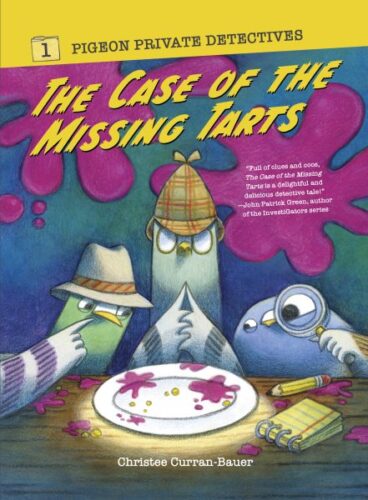
Gadzooks! Someone has stolen a delectable platter of jam tarts! Who would do such a thing? Fortunately, the Pigeon Private Detectives are on the case. Can you solve the mystery too? I am a sucker for a mystery. As a kid, I was the one just scouring the bookshelves for any title that even hinted at mysterious goings on. As a result, I’ve grown up to become a super stickler when it comes to mystery titles playing fair with kids. I am happy to report that this title most certainly plays fair, and has a bit of fun along the way. It walks that difficult line between easy book and early chapter titles, filling the pages with copious illustrations. It’s sort of a graphic novel/early chapter book hybrid of sorts. I count it as a success, though, because I guessed who the true culprit was early on and turned out to be right. And if I can get it, then it definitely plays fair.
Chloe’s Nature Journal by Miri Leshem-Pelly

Think that there aren’t any animals in your backyard? Think again! Join Chloe as she uses patience and observation to locate and draw the myriad wonders working hard where no one else is looking. Okay, folks. You want a hand-on early chapter book about a girl getting up close and personal with nature itself? This is burgeoning scientist matter at its best. In fact, it almost feels calculated to get kids to follow in Chloe’s footsteps, recording their own observations in the mini wild. I like the design that feels a mix of notebook novels and fun science. It’s not what I would call a plot forward book, but that’s not really its point. Extra points for “The Seven Principles of ‘Leave No Trace’” found in the back of the book. I’d encourage parents to purchase this and give it as a gift alongside an empty journal.
Clarice Bean, Scram! by Lauren Child
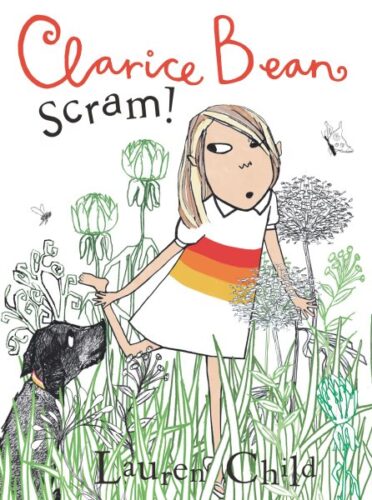
It isn’t that this is the first Clarice Bean book in the series, but I had to give it some extra points. As I’ve probably mentioned multiple times on my site, 2023 is the year of the dead dogs. I’m not even kidding you about that. Dogs are dying left and right in our children’s books this year and I simply don’t know how to account for it. So it’s almost a knee-jerk reaction to enjoy to a great extent a book in which a dog is so well tended as this one. Lauren Child long since established the way in which the Clarice Bean series is written, and this is very much in the same vein, but what a nice vein it is. If you or your nearby child has never read any of these books, I’d say that this one is a pretty good place to start. Clarice rides that fine line between wholly sympathetic and bratty so that she never quite tips over all the way onto one side or another. A good dog book about a good dog.
Dagfrid, Viking Girl: No More Ear Buns! by Agnès Mathieu-Daudé, ill. Olivier Tallec, translated by Nanette McGuinness

Fish. All Dagfrid ever gets to eat is fish. Well, she is sick of it! Off she sets in a boat her brother gave her to find glory and maybe, possibly, something different to eat in this fun early chapter book series starter. Fun! So this is a new series about a Viking girl who kicks against some of the trappings of her reality. In particular, her limited menu options. It’s funny, the title makes it sound like this book is going to be all about Dagfrid’s hair, but the actual story is far more about her quest to eat something other than fish. I rather liked how her family was presented and her relationship with her older brother. I should note that this is a book in which all the characters not only present as white but present as blond and white. That sort of becomes the point when Dagfrid meets another troop of blond white girls and the obvious joke is the teeny tiny differences between the two of them. Worth a read.
Drag and Rex: Forever Friends by Susan Lubner, ill. Blythe Russo

This one slips oh so slightly onto the early chapter book rather than easy book list, but just barely. I’m also going to give it some extra points for figuring out early on that when looking for new duos to pair as friends in a book series, a dino and a dragon is super fun. I mean, just look at that cover. Do you notice how Drag has a stuffed princess doll while Rex has a stuffed triceratops? Lubner goes for the odd couple groove in this book, with Rex being the careful, practical one and Drag being the impulsive wild child. Their adventures are split neatly into three little stories, and each little story has its own chapters. So for a kid that doesn’t think that they’re quite ready for chapter books yet, this title makes for excellent transition material. The stories are good, but full credit must be handed to Blythe Russo who is able to bring such charm to the watercolor art. Let me put it this way: Haven’t you always wanted to see a T.rex wearing a sweater with patches on the elbows? Well, now you can.
Henry, Like Always by Jenn Bailey, ill. Mika Song

In Classroom Ten, Henry relies on routines. Then, one day, his teacher announces that there will be a parade when there’s usually Share Time. A smart and reassuring book about a kid on the autism spectrum working around the unexpected. Writing a book about a kid on the spectrum is done often but rarely so well. The key here is to make Henry’s frustrations understandable. Even if you don’t agree with him, you have to see his point of view or it all falls apart. Jenn Bailey is just knocking this out of the park with the problem, the build, and a resolution that makes everyone happy (which, in cases like this, can be exceedingly difficult). I suspect that the fellow character of Samuel may have some impulse issues of his own, and now I’m hoping he gets his own spin-off series someday. Extra points for the use of humor. That Thinking Chair makes for a subtle but very effective page turn more than once and it never gets old. This is masterful.
Legends of Lotus Island: The Guardian Test by Christina Soontornvat
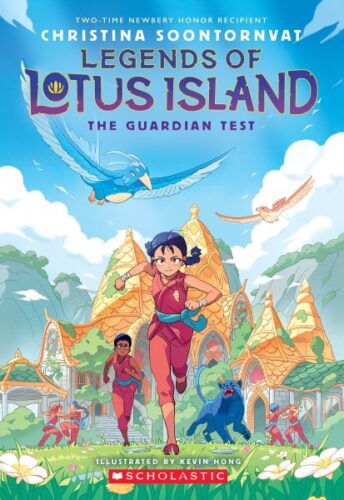
It’s interesting to include the aforementioned Henry and this latest from Christina Soontornvat on the same list. But when it comes to transitional books, Henry’s one of those early titles that’s for kids just getting into early chapter books, while Lotus Island is for kids just about ready to graduate into full-blown middle grade fiction reading. In this story, Plum is perfectly content to work in her grandparents’ garden, but that’s before she is called to join the elite Guardian Academy on Lotus Island. Will she be able to transform into an animal like everyone else or be forced to return home? It’s hard not to respect an early chapter book fantasy series based on the four basic principles of Buddhism, but if anyone can pull that off then it’s Christina Soontornvat! I had the pleasure of seeing her speak at the Andersen’s Breakfast this year and she discussed the creation of this particular book. As she tells it, during lockdown her kids got really into fantasy, but it can be hard to find short fantasy stories that operate on an epic, sweeping scale. This book is a just a touch longer than you’d consider a typical early chapter book to be, but I think it deserves this category since it can serve a bridge between some of the younger stuff and the 500+ page tomes of high fantasy out there. Great character development accomplished in a scant amount of time. Plus I got really wrapped up in the storyline. Two thumbs up!
The Rescues Finding Home by Tommy Greenwald and Charlie Greenwald, ill. Shiho Pate

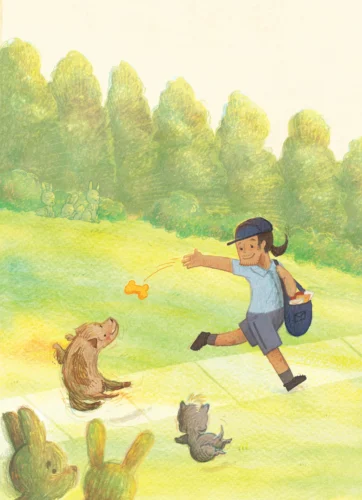
Small stories tell the tale of two shelter dogs who get adopted together and the tiny adventures they have before and after. Oo. This is rather charming. So it’s on the upper end of easy and the lower end of chapter books. I’ve enjoyed Tommy Greenwald’s books over the years but this is his first foray into this particular reading level, and I find it particularly interesting that he’s writing it with his son (click on the title of this entry to read my interview with the two of them together). I thought it managed to be cute without being cloying, which is no mean feat, particularly when you’re talking about puppies. This would be ideal for those programs where kids read to dogs, actually. A darn good addition to any list.
Salma Makes a Home by Danny Ramadan, ill. Anna Bron

ADVERTISEMENT
ADVERTISEMENT
I really love books filled to the brim with kid logic. I also like early chapter books that look like they’re going to be all sweetness and light, but offer a kind of interesting complexity instead. In this story, Syrian immigrant Salma and her mother have successfully made a life for themselves in Toronto while they wait for Salma’s father (or Baba) to make his way over as well. It’s been a year, eleven months, and six days since Salma saw Baba in Damascus so by this point she has thoroughly settled in. Finally she gets word that Baba’s coming, but what should be a purely joyful moment gets all wrapped up in Salma’s anxiety. What if Baba doesn’t like life in Toronto? Her fears seem to be well founded when her dad finds himself struggling with culture shock. It’s cold, he doesn’t speak the language, he doesn’t have his parents there, and now Salma is terrified that he’s going to leave them all and go back to Syria again. Without deep diving into world affairs or politics, Ramadan deftly gives you some completely understandable fears from a kid perspective while acknowledging a lot of what poor Baba is going through with this move. I’d say that while the ending isn’t all happy sunshine and flowers, it is hopeful and deeply satisfying. Art by Anna Bron works particularly well alongside the first in this series.
The Story of Gumluck the Wizard by Adam Rex

Gumluck is just a little wizard who lives in a big hill, but he aspires to be more. Fortunately he has his new friends, a tiny ghost named Butterscotch and a crotchety raven named Helvetica, to help him on his way. Aww. Whatta sweetie! I never pegged Adam Rex as someone who could necessarily do sweet (or, for that matter, want to) but I can tell you right now that I was charmed by this story. Like Helvetica the raven, it’s impossible not to like Gumluck after a while. He’s a people pleaser, and that’s a kind of character we don’t see all that often in our children’s books. There are plenty of jokes for kids to get, plenty of jokes for adults to get (I literally laughed embarrassingly loudly in the staff room at a fig-related joke), and even a pint or two of wisdom in there. What more could you possibly want in a book?
Too Small Tola Gets Tough by Atinuke, ill. Onyinye Iwu
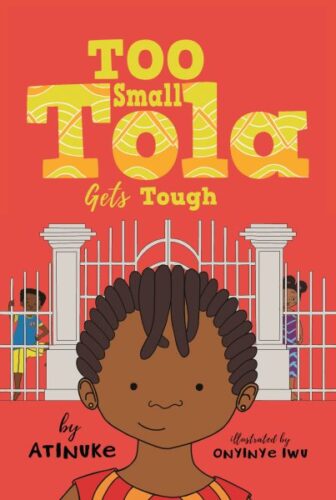
When the pandemic hits Lagos, Nigeria, Tola finds herself working as a housegirl for the super rich, to help her family. And when her love of numbers comes in handy, she proves that even if you’re small you can still save the day.I couldn’t resist. I try to avoid sequels as a rule on my lists but every Too Small Tola title in the series stands entirely on its own and this one is SUCH a good one! In it, the pandemic hits Lagos and hits it hard. I can’t think of a single children’s book that’s ever explored what kids had to deal with during lockdown in other countries. Plus you know my fondness for math titles and this book is positively brimming with it! I didn’t find it particularly farfetched to believe that Tola could be the one to save the day here. And as with all of Atinuke’s books, there is a lot here that adults will understand that’s above and beyond what kids will. An absolute winner (and funny to boot). Previously Seen On: The Math list
When Dad’s Hair Took Off by Jörg Mühle, translated by Melody Shaw



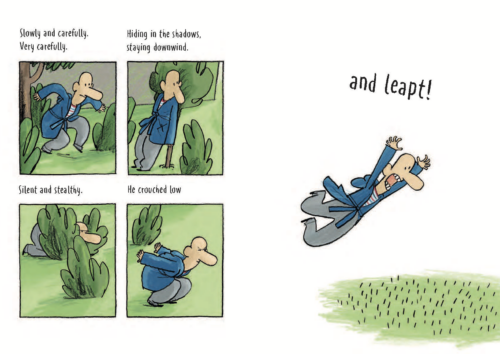
“Dad’s hair was sick of being brushed and combed.” Watch what happens when one man’s follicles take off to see the world … without him! Okay, I don’t want to hear any more jibes about how the Germans don’t have a sense of humor. When it comes to their children’s literature, they are veritable humor experts. And you pretty much will know everything there is to know about the plot of this book from its title. Admittedly, I think that this is secretly a very funny book for those dads suffering from male pattern baldness (particularly when you look at the lengths to which Dad here will travel to get his hair back). It’s a book of a funny length, but great for bedtimes or for young readers who want to feel like they’re reading a “real” book, in terms of its size. Oh, and 100 points to translator Melody Shaw who is working her butt off with this wordplay. I think this may have been a much harder assignment than she originally signed up for. It also happens to be a perfect companion to this year’s picture book Mr. Fiorello’s Head by Cecilia Ruiz (seen on this year’s Unconventional list).
Hope you enjoyed these! Here are the lists you can expect for the rest of this month:
December 1 – Great Board Books
December 2 – Picture Book Readaloud
December 3 – Simple Picture Book Texts
December 4 – Transcendent Holiday Picture Books
December 5 – Rhyming Picture Books
December 6 – Funny Picture Books
December 7 – CaldeNotts
December 8 – Picture Book Reprints
December 9 – Math Books for Kids
December 10 – Gross Books
December 11 – Books with a Message
December 12 – Fabulous Photography
December 13 – Translated Picture Books
December 14 – Fairy Tales / Folktales / Religious Tales
December 15 – Wordless Picture Books
December 16 – Poetry Books
December 17 – Unconventional Children’s Books
December 18 – Easy Books & Early Chapter Books
December 19 – Older Funny Books
December 20 – Science Fiction Books
December 21 – Fantasy Books
December 22 – Comics & Graphic Novels
December 23 – Informational Fiction
December 24 – American History
December 25 – Science & Nature Books
December 26 – Unique Biographies
December 27 – Nonfiction Picture Books
December 28 – Nonfiction Books for Older Readers
December 29 – Audiobooks for Kids
December 30 – Middle Grade Novels
December 31 – Picture Books
Filed under: 31 Days 31 Lists, Best Books, Best Books of 2023
About Betsy Bird
Betsy Bird is currently the Collection Development Manager of the Evanston Public Library system and a former Materials Specialist for New York Public Library. She has served on Newbery, written for Horn Book, and has done other lovely little things that she'd love to tell you about but that she's sure you'd find more interesting to hear of in person. Her opinions are her own and do not reflect those of EPL, SLJ, or any of the other acronyms you might be able to name. Follow her on Twitter: @fuseeight.
ADVERTISEMENT
ADVERTISEMENT
SLJ Blog Network
Name That LEGO Book Cover! (#53)
Exclusive: Vol. 2 of The Weirn Books Is Coming in October | News
Fighting Public School Book Bans with the Civil Rights Act
Take Five: Middle Grade Anthologies and Short Story Collections
ADVERTISEMENT








Time to max out my library holds after reading this! Thanks for another awesome list! 1. Glad to see your note about how Nat the Cat books could be read between a new reader and a better reader. This year I began tutoring students in reading using an Orton-Gillingham curriculum and I’ve become so aware of how few great trade books there are that have phonics patterns that new/ struggling readers can sound out. I’ll give this one a try! 2. My graphic novel loving 4th grader loved the Lotus Island Series 🙂
I love your book lists. I wonder if you might do a list of chapter books one year?
Coming up! I call them Middle Grade Fiction. You’ll see them on the 30th.
Well, there go my order carts for the next couple of months – and we’re only on day 18 😀 I can’t tell you how much I look for to 31 every year and I feel like I get better ideas for books to buy for kids than from any other source throughout the year. Thank you for all the work you put into reading so many books and writing such great review, Betsy!
Betsy, in my career I was a reading specialist and worked many years with students in Grades K-3. I thought I knew the definition of “easy” and “early chapter” books and I thought I understood the gradual acquisition of vocabulary, skills and comprehension. Reading instruction has changed but I find myself confused by the few examples you have included of the actual text of the books reviewed here. I look at the text you included for BEAR AND BIRD and WHEN DAD’S HAIR TOOK OFF and find the words quite complex for a beginning reader.
Because of my interest in dogs and participation in a Read To a Dog program, I’m interested in looking at THE RESCUES FINDING HOME and CLARENCE BEAN SCRAM.
Because I eschew leveling, you will indeed find books here with individual words just a bit too complex for Lexile, A.R., etc. Nevertheless, I would defend them to my death. These belong on these lists. Give ’em a read, and I suspect you will agree. Yoink!